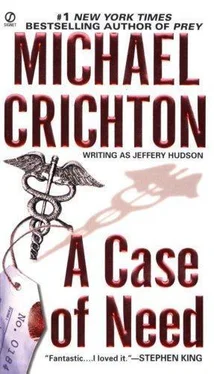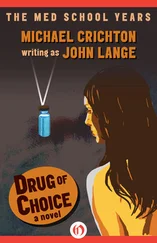Michael Crichton - A Case of Need
Здесь есть возможность читать онлайн «Michael Crichton - A Case of Need» весь текст электронной книги совершенно бесплатно (целиком полную версию без сокращений). В некоторых случаях можно слушать аудио, скачать через торрент в формате fb2 и присутствует краткое содержание. Город: New York, Год выпуска: 2003, ISBN: 2003, Издательство: Signet, Жанр: thriller_medical, на английском языке. Описание произведения, (предисловие) а так же отзывы посетителей доступны на портале библиотеки ЛибКат.
- Название:A Case of Need
- Автор:
- Издательство:Signet
- Жанр:
- Год:2003
- Город:New York
- ISBN:9780451210630
- Рейтинг книги:5 / 5. Голосов: 1
-
Избранное:Добавить в избранное
- Отзывы:
-
Ваша оценка:
- 100
- 1
- 2
- 3
- 4
- 5
A Case of Need: краткое содержание, описание и аннотация
Предлагаем к чтению аннотацию, описание, краткое содержание или предисловие (зависит от того, что написал сам автор книги «A Case of Need»). Если вы не нашли необходимую информацию о книге — напишите в комментариях, мы постараемся отыскать её.
A Case of Need — читать онлайн бесплатно полную книгу (весь текст) целиком
Ниже представлен текст книги, разбитый по страницам. Система сохранения места последней прочитанной страницы, позволяет с удобством читать онлайн бесплатно книгу «A Case of Need», без необходимости каждый раз заново искать на чём Вы остановились. Поставьте закладку, и сможете в любой момент перейти на страницу, на которой закончили чтение.
Интервал:
Закладка:
He laughed until he was crying. “Blinded by religion,” he kept saying, doubled over in laughter. “Blinded by religion.”
The surgeon did plastic stuff, and he didn’t see the humor. I guess because he’d repaired too many punched-out eyesockets. But Art was convulsed.
Most people at the party were surprised by his laughter; they thought it was excessive and in rather poor taste. I suppose of all the people there I was the only one who understood the significance of this joke to Art. I was also the only one who knew the great strains under which he worked.
Art is my friend, and he has been ever since we went to medical school together. He’s a bright guy and a skilled doctor, and he believes in what he’s doing. Like most practicing doctors, he tends to be a little too authoritarian, a little too autocratic. He thinks he knows what’s best, and nobody can know that all the time. Maybe he goes overboard, but I can’t really knock him. He serves a very important function. After all, somebody around here has to do the abortions.
I don’t know exactly when he started. I guess it was right after he finished his gynecology residency. It’s not a particularly difficult operation—a well-trained nurse can do it with no problem. There’s only one small catch.
It’s illegal.
I remember very well when I first found out about it. There was some talk among some of the path residents about Lee; they were getting a lot of D & C’s that were positive. The D & C’s had been ordered for a variety of complaints—menstrual irregularity, pain, mid-period bleeding—but quite a few were showing evidence of pregnancy in the scrapings. I got concerned because the residents were young and loose-mouthed. I told them right there in the lab that it wasn’t funny, that they could seriously damage a doctor’s reputation by such jokes. They sobered up quickly. Then I went to see Arthur. I found him in the hospital cafeteria. “Art,” I said, “something’s bothering me.” He was in a jovial mood, eating a doughnut and coffee. “Not a gynecological problem, I hope.” He laughed.
“Not exactly. I overheard some of the residents say that you had a half-dozen pregnancy-positive scrapings in the last month. Have you been notified?”
Immediately, the hearty manner was gone. “Yes,” he said, “I have.”
“I just wanted you to know. There might be trouble in the tissue committee when these things come up, and—”
He shook his head. “No trouble.”
“Well, you know how it looks.”
“Yes,” he said. “It looks like I’m performing abortions.”
His voice was low, almost dead calm. He was looking directly at me. It gave me a strange feeling. “We’d better have a talk,” he said. “Are you free for a drink about six tonight?”
“I guess so.”
“Then meet me in the parking lot. And if you get some free time this afternoon, why don’t you have a look at a case of mine?”
“All right,” I said, frowning.
“The name is Suzanne Black. The number is AO—two-two-one-three-six-five.”
I scribbled the number on a napkin, wondering why he should have remembered it. Doctors remember a lot about their patients, but rarely the hospital number.
“Take a good look at this case,” Art said, “and don’t mention it to anyone until you talk to me.”
Puzzled, I went back to work in the lab. I was up for an autopsy that day, so I wasn’t free until four in the afternoon. Then I went to the record room and pulled the chart for Suzanne Black. I read it right there—it wasn’t very long. She was Dr. Lee’s patient, first admitted at age twenty. She was a junior at a local Boston college. Her CC [6] Chief complaint, the term for the medical disorder that brings the patient to seek treatment.
was menstrual irregularity. Upon questioning, it was revealed that she had recently suffered a bout of German measles, had been very tired afterward, and had been examined by her college doctor for possible mononucleosis. She reported irregular spotting approximately every seven to ten days, but no normal flow. This had been going on for the last two months. She was still tired and lethargic.
Physical examination was essentially normal, except that she had a mild fever. Blood tests were normal, though hematocrit [7] A test of the amount of hemoglobin, or red cells, in the blood.
was somewhat low.
Dr. Lee ordered a D & C to correct her irregularity. This was in 1956, before the advent of estrogen therapy. The D & C was normal; no evidence of tumors or pregnancy. The girl seemed to respond well to this treatment. She was followed for the next three months and had normal periods.
It looked like a straightforward case. Illness or emotional stress can disrupt a woman’s biological clock, and throw off her menses; the D & C reset that clock. I couldn’t understand why Art had wanted me to look at it. I checked the path report on the tissue. It had been done by Dr. Sanderson. The write-up was brief and simple: gross appearance normal, micro examination normal.
I returned the chart and went back to the lab. When I got there, I still couldn’t imagine what the point of the case was. I wandered around, doing odds and ends, and finally began the work-up on my autopsy.
I don’t know what made me think of the slide. Like most hospitals, the Lincoln keeps path slides on file. We save them all; it is possible to go back twenty or thirty years and reexamine the microscopic slides from a patient. They’re stored in long boxes arranged like card catalogs in a library. We had a whole room full of such boxes.
I went to the appropriate box and found slide 1365. The label gave the case number and Dr. Sanderson’s initials. It also said in large letters, “D & C.”
I took the slide back to the micro room, where we have ten microscopes in a long row. One was free; I slipped the slide onto the stage and had a look.
I saw it immediately.
The tissue was a uterine scraping, all right. It showed a rather normal endometrium in the proliferative phase, but the stain stopped me. This slide had been stained with Zenker-Formalin stain, giving everything a brilliant blue or green color. It was a rather unusual stain, employed for special diagnostic problems.
For routine work, the Hematoxylin-Eosin stain is used, producing pink and purple colors. Almost every tissue slice is stained with H & E, and if this is not the case, the reasons for the unusual stain are noted in the pathological summary.
But Dr. Sanderson had not mentioned that the slide was Zenker-Formalin.
The obvious conclusion was that the slides had been switched. I looked at the handwriting on the label. It was Sanderson’s, no doubt about it. What had happened?
Almost immediately, other possibilities came to mind. Sanderson had forgotten to note in his report that an unusual stain was used. Or two sections were made, one H & E, the other Zenker-Formalin, and only the Zenker was saved. Or that there had been some legitimate mixup.
None of these alternatives was particularly convincing. I thought about it and waited impatiently until six that evening, when I met Art in the parking lot and got into his car. He wanted to go someplace away from the hospital to talk. As he drove, he said, “Read the case?”
“Yes,” I said. “Very interesting.”
“You checked the section?”
“Yes. Was it the original?”
“You mean, was it a scraping from Suzanne Black? No.”
“You should have been more careful. The stain was different. That kind of thing can get you into trouble. Where did the slide come from?”
Art smiled thinly. “A biological supply house. ‘Slide of normal endometrial scraping.’ ”
“And who made the switch?”
“Sanderson. We were new to the game, in those days. It was his idea to put in a phony slide and write it up as normal. Now, of course, we’re much more refined. Every time Sanderson gets a normal scraping, he makes up a few extra slides and keeps them around.”
Читать дальшеИнтервал:
Закладка:
Похожие книги на «A Case of Need»
Представляем Вашему вниманию похожие книги на «A Case of Need» списком для выбора. Мы отобрали схожую по названию и смыслу литературу в надежде предоставить читателям больше вариантов отыскать новые, интересные, ещё непрочитанные произведения.
Обсуждение, отзывы о книге «A Case of Need» и просто собственные мнения читателей. Оставьте ваши комментарии, напишите, что Вы думаете о произведении, его смысле или главных героях. Укажите что конкретно понравилось, а что нет, и почему Вы так считаете.









